How to Get Approval to Sell Toys on Amazon
Download Amazon Seller Guide
This guide will help you get started, understand the basics of Amazon selling, and explain in simple words how it all works.
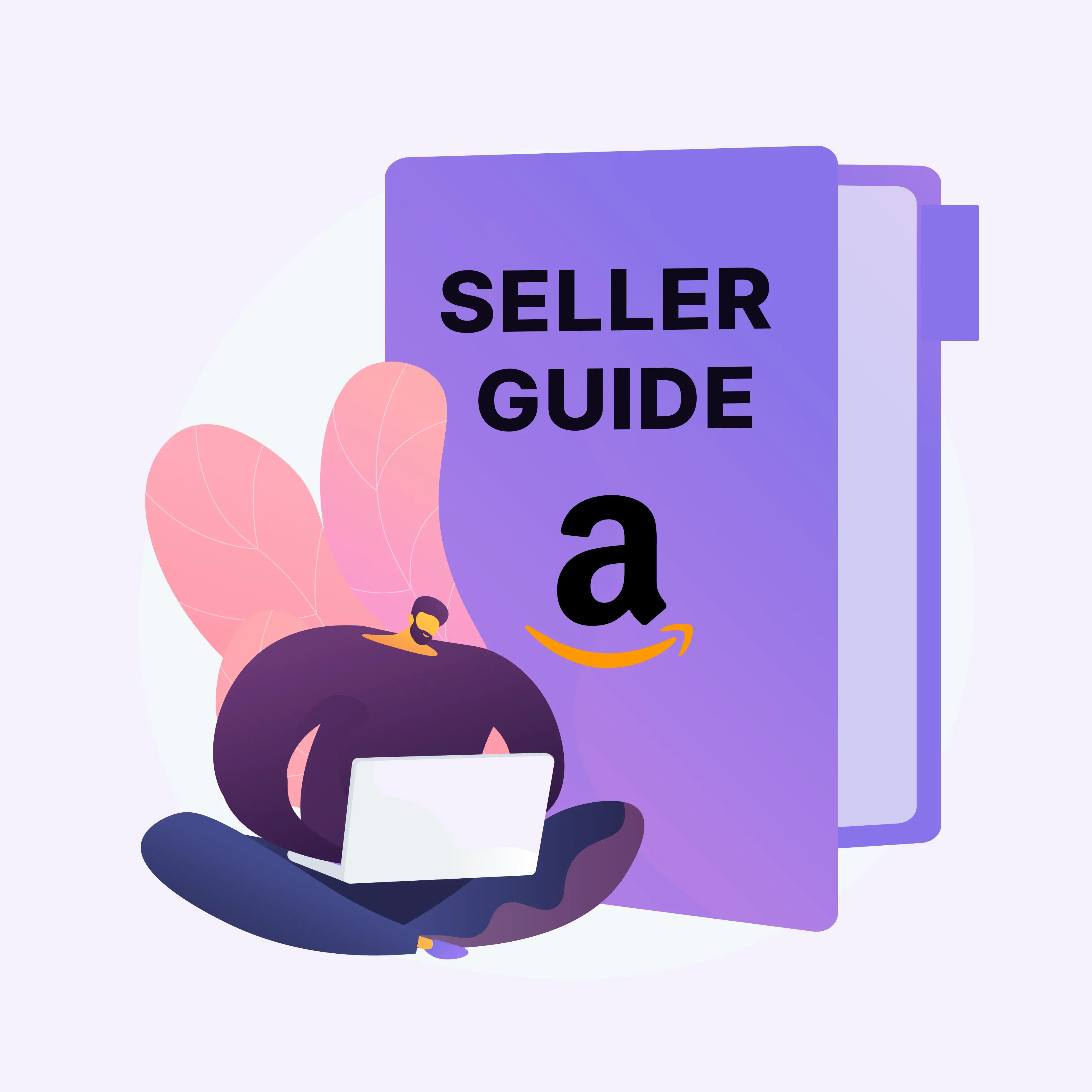
Selling toys on Amazon can be incredibly profitable, but it’s also one of the most restricted areas for new sellers. Toy brands, safety rules, and holiday gating catch many wholesale, online arbitrage, and dropshipping sellers off guard – especially when approvals get denied without explanation.
The good news? Getting approved isn’t complicated once you know exactly what Amazon requires and how to prepare your invoices, product photos, and safety documents the right way.
This post breaks down how toy gating works, how to check any toy for restrictions, and the exact steps to get approved faster with fewer rejections.
What Amazon’s Toy Approval Really Means
Amazon’s toy approval process exists to protect customers, especially children, from unsafe or counterfeit products. Unlike many other categories, toys involve strict safety laws, brand protection rules, and seasonal restrictions – so Amazon vets sellers more thoroughly before letting them list these items. Understanding how toy gating works helps you avoid rejections, unnecessary appeals, and lost time when sourcing inventory.
Why toys require brand-level ungating
Unlike other categories, in the Toys and Games category, most toy restrictions sit at the brand level – LEGO, Barbie, Hot Wheels, Funko, Nerf, and other top brands. They all require their own individual approvals. This is because popular toy brands face the highest rates of counterfeiting, and Amazon must verify that your supply chain is legitimate for each brand you sell.
For sellers, this means every brand you source may require its own 10-unit invoice, product photos, and application. Once approved in one brand, you may automatically get ungated for related brands, but each stands alone in Amazon’s system.
Holiday approval vs. year-round approval
Amazon increases toy safety controls during Q4, when customer demand spikes. Holiday approval is a temporary requirement that applies only during peak shopping months. If you haven’t met Amazon’s performance and safety criteria, your toy listings may be blocked until you qualify.
Outside Q4, most toy brands still require approval, but you won’t face holiday-specific rules. Year-round approval focuses on invoices, supplier legitimacy, and product authenticity – not your performance metrics. Still, both approval types ensure that only compliant sellers list toys when demand is highest.
What Amazon checks
Every toy application goes through three main checks:
Safety
Toys must comply with U.S. laws, including ASTM F963-23, CPSIA, and CPC requirements for children’s products. Some toys need CPSC-accepted lab testing, especially items intended for ages 12 and under.
Authenticity
Amazon verifies invoices, supplier legitimacy, and product packaging to ensure items aren’t counterfeit. Retail receipts are rarely accepted; clean invoices are essential.
Compliance
Amazon ensures your documentation matches your seller account, product photos show actual inventory, and the item isn’t on the prohibited toys list. Any mismatch can trigger rejection.
These checks protect buyers and create a safer, more trustworthy marketplace – making proper preparation essential for fast toy approval.
How to Check Toy Restrictions in Bulk
The most efficient way to confirm eligibility is to check restrictions directly during sourcing – not after you’ve already reviewed the product. Seller Assistant's Price List Analyzer integrates restriction checks into your research process, allowing you to spot profitable and sellable items at the same time.
When you upload a supplier catalog, the tool automatically maps each product to the correct Amazon ASIN, calculates all profitability metrics, and displays restriction status inside one dashboard. This automation cuts hours of manual verification, prevents you from buying items you can’t sell, and keeps you focused on products your account is approved for.
Note. Seller Assistant is an end-to-end Amazon workflow management platform that integrates 10+ wholesale-focused solutions into one connected system. It combines sourcing workflow automation, bulk research and intelligence tools, and integrated Chrome extensions – giving you everything you need to streamline finding deals, managing suppliers, and creating purchase orders.

The platform aggregates: workflow management tools – Purchase Orders Module, Suppliers Database, Warehouses Database to organize, automate, and scale every step of your Amazon wholesale and arbitrage operations; bulk research & sourcing tools – Price List Analyzer, Bulk Restriction Checker, Sourcing AI, Brand Analyzer, Seller Spy to evaluate supplier price lists, verify selling eligibility and restrictions, open new brands, and discover winning product ideas from competitors to expand your product catalog; Chrome extensions – Seller Assistant Browser Extension, IP-Alert Extension, and built-in VPN by Seller Assistant to deep-research products, check IP claims and compliance, and access geoblocked supplier sites directly within your browser; and integrations & team access features – seamless API connectivity and integrations with Zapier, Airtable, and Make, plus Virtual Assistant Accounts for secure, scalable team collaboration.
With Seller Assistant, every step of your Amazon wholesale and arbitrage workflow is automated and connected.
What Price List Analyzer does
Price List Analyzer is designed for wholesale, OA, and dropshipping sellers who handle large supplier files. It processes spreadsheets, identifies ASIN matches, and calculates detailed profitability figures – letting you uncover the strongest opportunities in minutes.

The tool adds more than 100 data points to your spreadsheet, including sales history, Buy Box trends, Amazon fees, competition indicators, ROI, and restriction alerts. You can filter results, highlight high-value ASINs, and adjust cost inputs to update profit instantly.
Built for accuracy and speed, Price List Analyzer supports confident sourcing decisions with comprehensive, real-time data.
Price List Analyzer turns complex supplier sheets into simple, actionable results. It identifies ASIN matches, evaluates product risks, and highlights low-risk, high-profit options – usually within minutes.
What Price List Analyzer helps you achieve
How to Analyze Suppliers’ Price Lists in Bulk | Price List Analyzer Review
- Analyze large supplier files and quickly spot high-margin, low-risk products.
- Automatically match supplier SKUs to their Amazon ASINs.
- Check restriction status and flag products your account cannot list.
- Add 100+ metrics to your spreadsheet, including: sales performance – BSR, trend direction, estimated sales, velocity; profitability – net profit, ROI, margins, break-even; pricing trends – average Buy Box for 30/90/180 days; Amazon fees – FBA/FBM fees, referral, storage, shipping, prep, HazMat; competition – number of sellers, Buy Box shares, Amazon involvement
- Detect product risks (oversize, HazMat, meltable, fragile, IP-sensitive, bundles).
- Use alerts like ASIN Not Found, No FBA Fees, No Buy Box, No COGs, Approval Required.
- Filter deals by ROI, sales velocity, or risk level.
- Customize and save table layouts for repeated use.
- Mark products with Likes/Dislikes, create purchase lists, and export ASINs.
- Adjust COGs, shipping, or prep costs and get updated profit instantly.
- Add shared notes that reappear whenever the same ASIN is uploaded again.
How to check restrictions using Price List Analyzer

When your supplier file is processed, Price List Analyzer assigns one of three restriction statuses:
- Eligible – you can sell the item (green open lock).
- Approval required – gated and needs authorization (red closed lock).
- Ineligible – your account can’t sell it (red closed lock with exclamation mark).
These instant checks show which ASINs you can list, which require ungating, and which to avoid – saving time and preventing compliance issues.
How to use Price List Analyzer
Step 1. Upload your supplier file
Open Price List Analyzer from Seller Assistant personal account. Upload your CSV or Excel file with UPC/EAN identifiers and cost of goods. The tool automatically finds ASIN matches, analyzes them, and fills the table with all calculations and warnings.
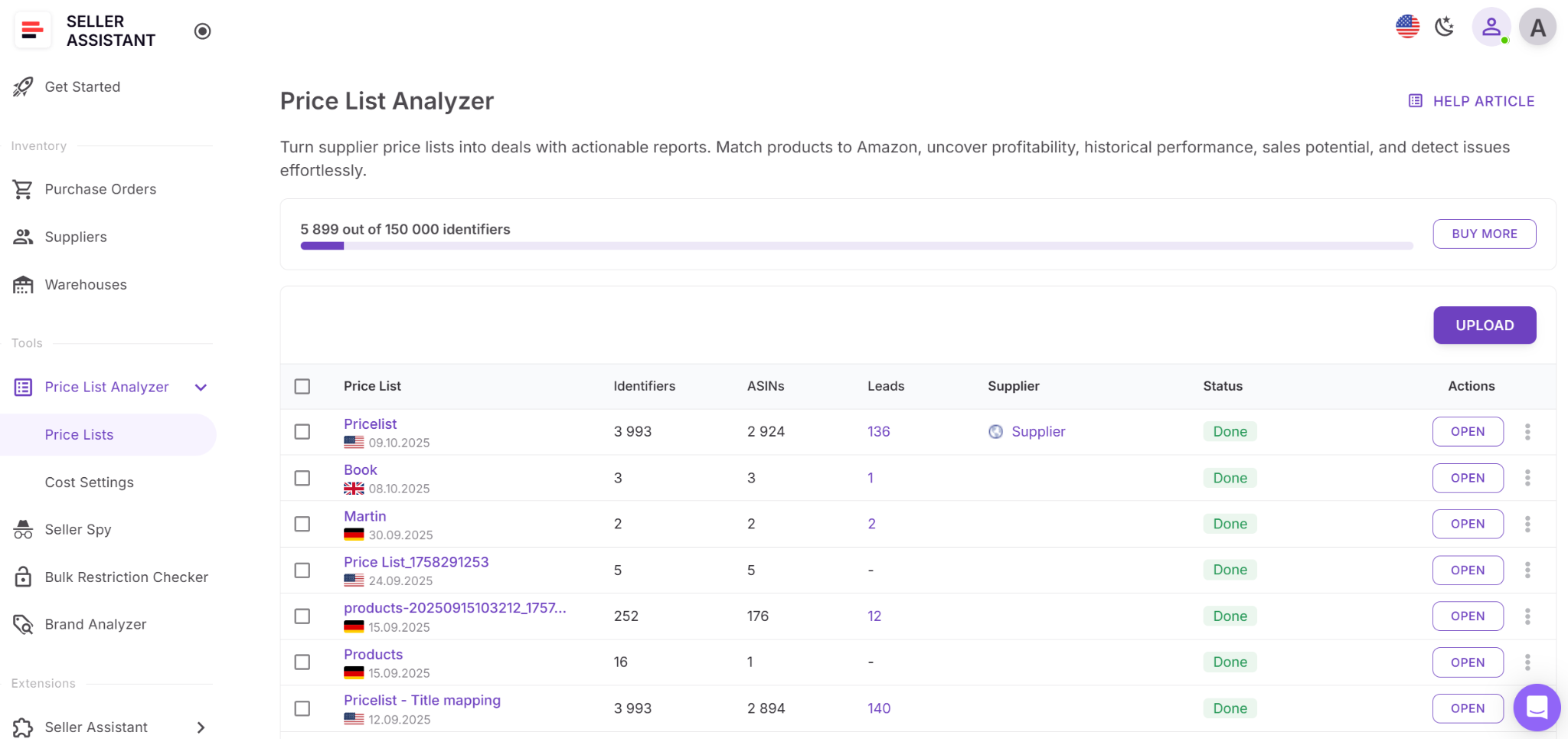
Step 2. Locate the restriction indicators
After processing, open the Listing restrictions column. Each product will show a lock icon:
- Green open lock – eligible
- Red closed lock – approval required
- Red closed lock + exclamation – not eligible

Step 3. Review all unsellable or gated products
Scroll through rows with red locks. Hover over the icon or check the Warnings column to identify whether the problem is brand gating, category restrictions, or a general approval requirement.
Step 4. Filter your file by restriction type
Open Filters → Restrictions, or filter by specific lock icons. Combine restriction filters with ROI, profit, or sales filters to find gated products you may want to apply for ungating.
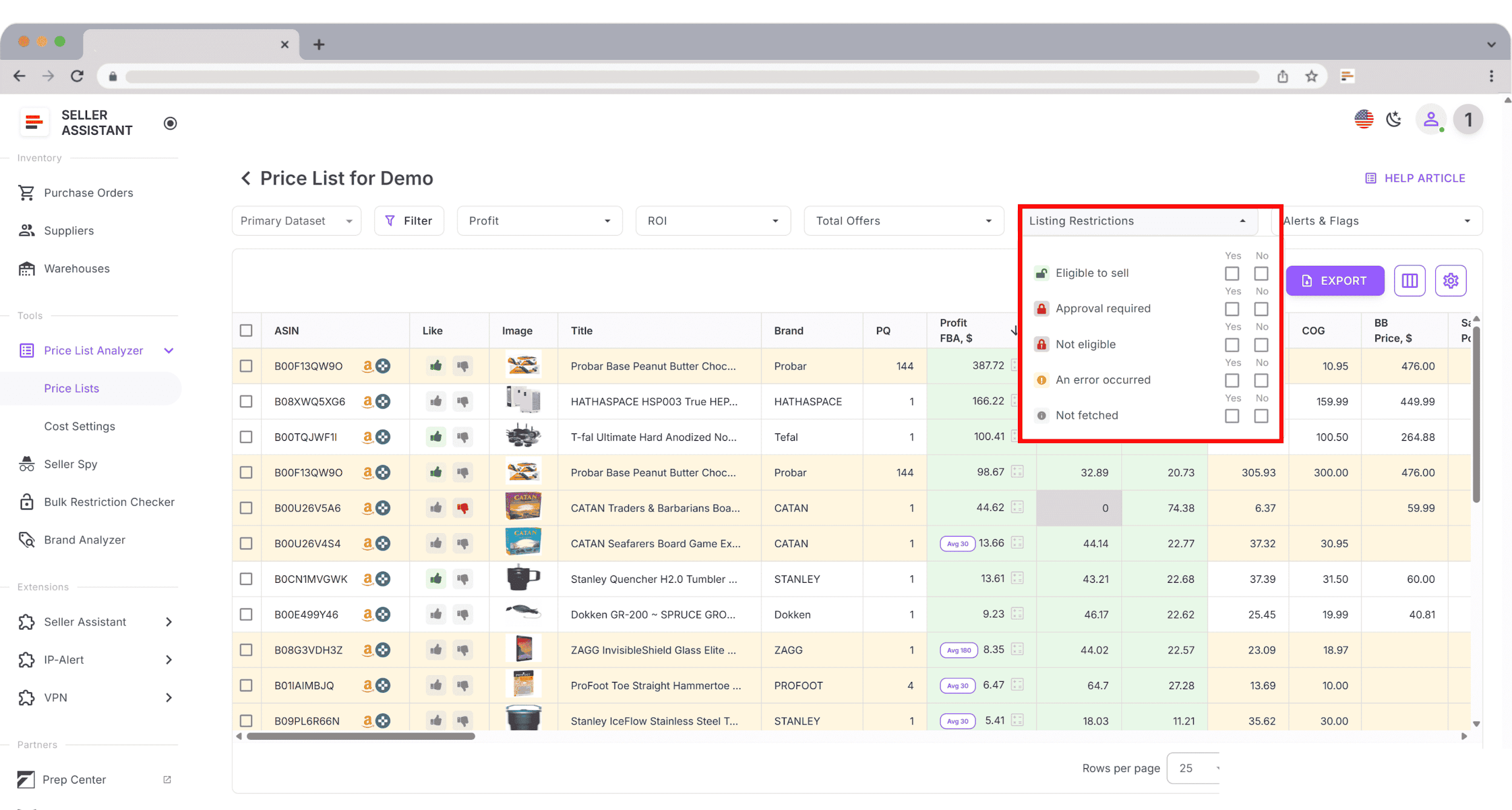
Step 5. Choose your next step
- Approval required: Decide whether the brand or category is worth applying for.
- Ineligible: Skip sourcing until your account qualifies.
- Eligible: Proceed, but confirm IP, HazMat, or prep alerts before purchasing.
Step 6. Save your table view
Save your preferred setup – such as “Sellable Only,” “Ungating Targets,” or “Restricted Items.” These saved views help you process future supplier lists faster and maintain a consistent workflow.

What You Need Before Applying For Toy Approval
Before you submit a toy approval request, Amazon expects proof that your products are genuine, safe, and sourced through legitimate channels. Having all required documents prepared in advance helps prevent delays and significantly increases your chances of getting approved on the first attempt.
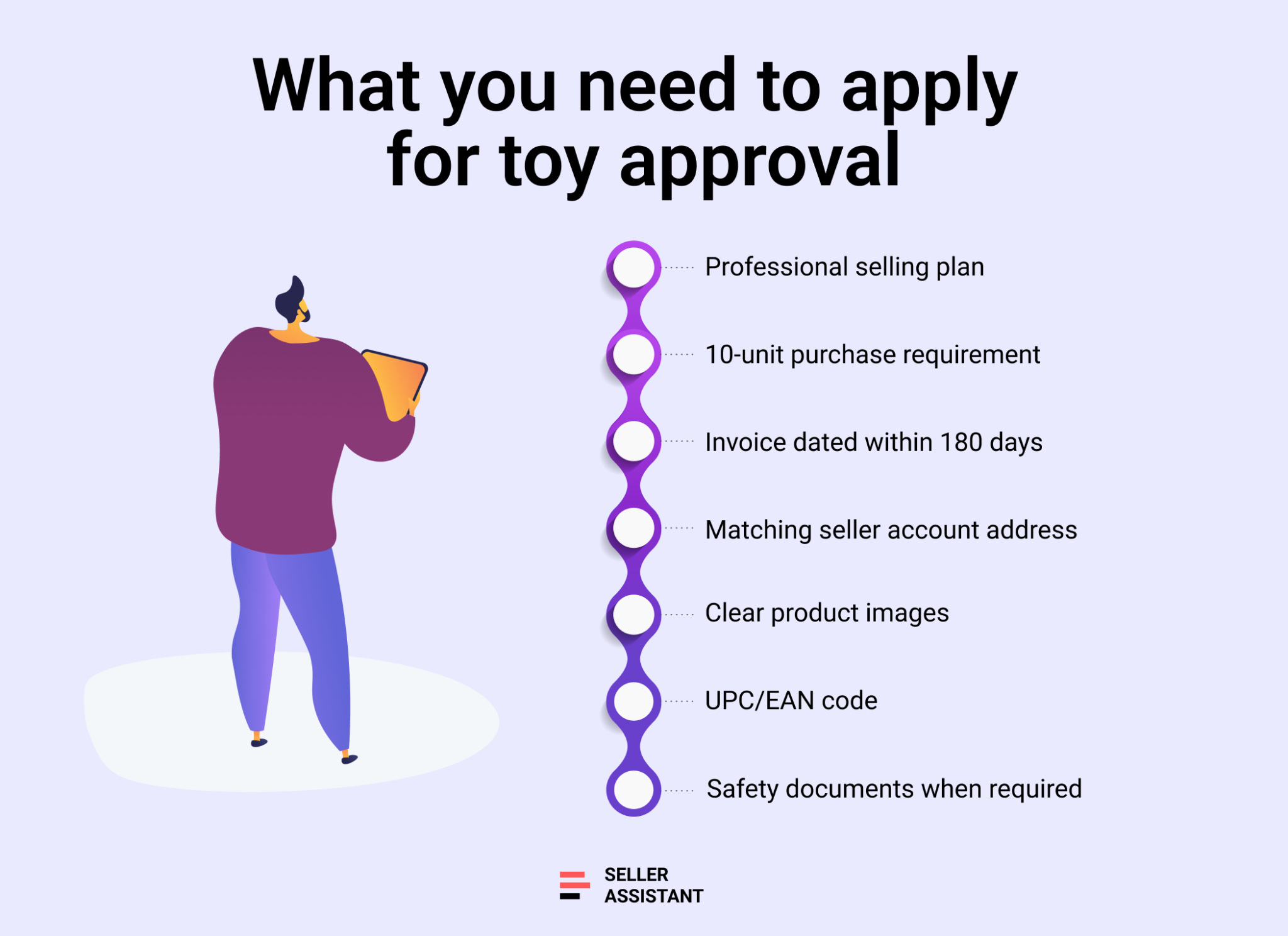
Professional account
A professional selling plan is required to apply for toy and brand approvals. Amazon doesn’t allow Individual plan accounts to request category or brand ungating.
10-unit minimum purchase requirement
Every application must include proof that you purchased at least ten units of the exact product you’re trying to get approved for. These units must be bought from a legitimate retailer or distributor Amazon accepts.
Invoices dated within 180 days
Your invoice must be less than 180 days old and clearly show the quantity purchased, supplier details, and your shipping address. Amazon uses it to verify that your supply chain is recent and compliant.
Matching seller account address
The address on your invoice must match the address registered in your Amazon Seller Central account. Any mismatch – PO box issues, old addresses, or business name variations – can trigger an instant rejection.
Clear product images
Amazon requires high-quality photos showing all sides of the product, preferably on a white background. These images help Amazon confirm the product matches the invoice and isn’t counterfeit or repackaged.
UPC/EAN
Most toys require valid UPC or EAN identifiers to match your product accurately to an existing ASIN. This helps Amazon confirm you're applying for the correct listing and reduces application errors.
Safety documentation when required
Some toys need CPSIA documentation such as CPCs or test reports from a CPSC-accepted lab. These documents prove the product meets U.S. child safety standards and is legally allowed to be sold.
Toy Safety Certifications Amazon Requires
Amazon requires strict safety documentation for any toy intended for children. Every toy must meet U.S. safety laws, include the correct compliance paperwork, and be sold only in new condition – Amazon does not allow used, refurbished, or collectible toys in this category.
ASTM F963-23
ASTM F963-23 is the mandatory U.S. Toy Safety Standard covering mechanical, chemical, and physical hazards. Amazon requires proof that your product complies with this standard before it can be approved for sale.
CPSIA
CPSIA regulates all children’s products and ensures they meet federal limits for lead, phthalates, and labeling requirements. Your toy must comply with CPSIA rules to be legally sold on Amazon.
Children’s product certificate (CPC)
A CPC is a manufacturer-issued document confirming the toy meets all required safety standards. Amazon may request your CPC during the approval process or later during routine compliance checks.
CPSC-accepted lab testing
If your toy is intended for children aged 12 and under, testing must be performed by a CPSC-accepted laboratory. These reports verify that your toy meets all required safety and chemical standards before reaching Amazon customers.
Step-by-step – How to Apply for Toy Approval
Before Amazon allows you to sell toys, you must submit a brand or product approval request. The process happens inside Seller Central and follows the same flow as listing an existing Amazon product – except that instead of adding your offer, Amazon asks you to upload documents proving your inventory is authentic, safe, and sourced correctly.

Step 1. Go to Add a product
Log in to Seller Central and open Catalog > ‘Add Products.’ This is where you search Amazon’s catalog to find the exact toy you want to sell and check whether the ASIN requires approval.

Step 2. Paste the ASIN
In the search bar under Find your products in Amazon’s catalog, paste the toy’s ASIN. You can also search by title, image, or link, but using the ASIN ensures you land on the correct listing without duplicates.
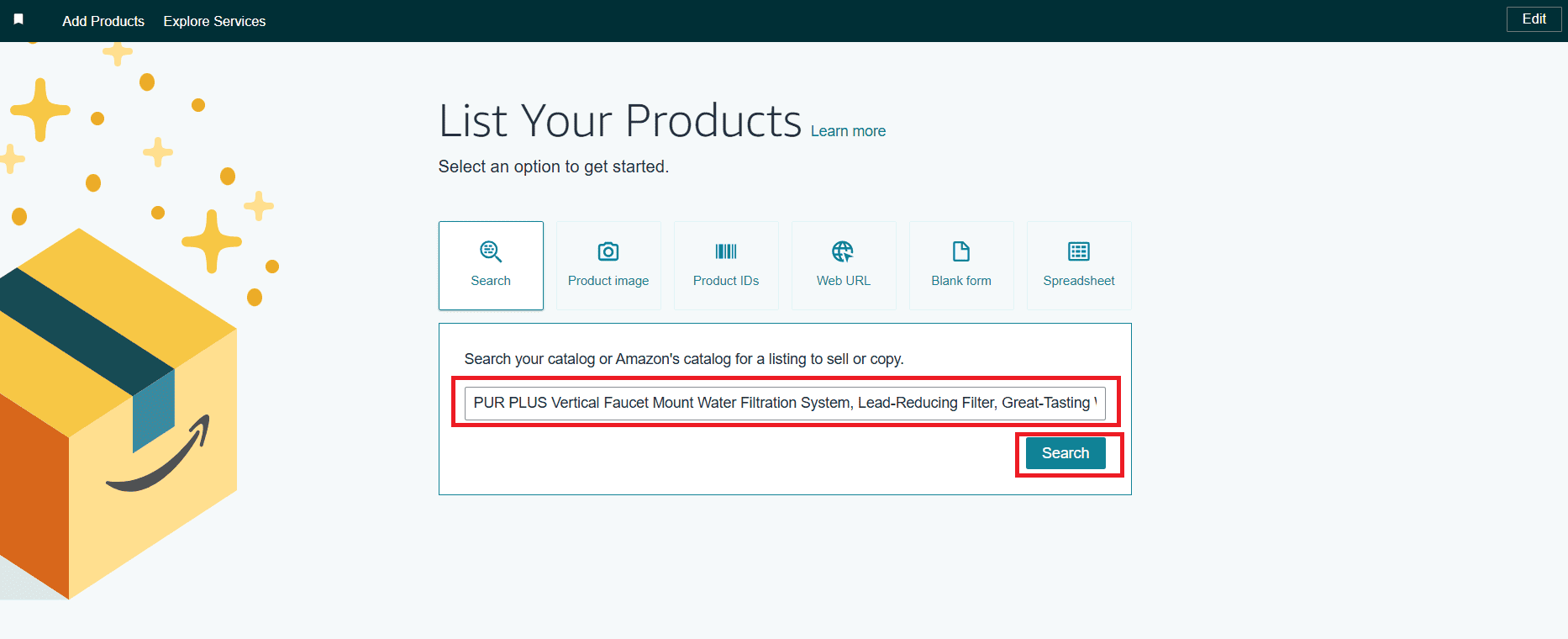
Step 3. Click “Apply to sell”
Open the product from the search results and choose the product condition. Instead of “Sell this product,” you’ll see “Apply to sell,” which indicates that Amazon requires approval for this toy brand or category. 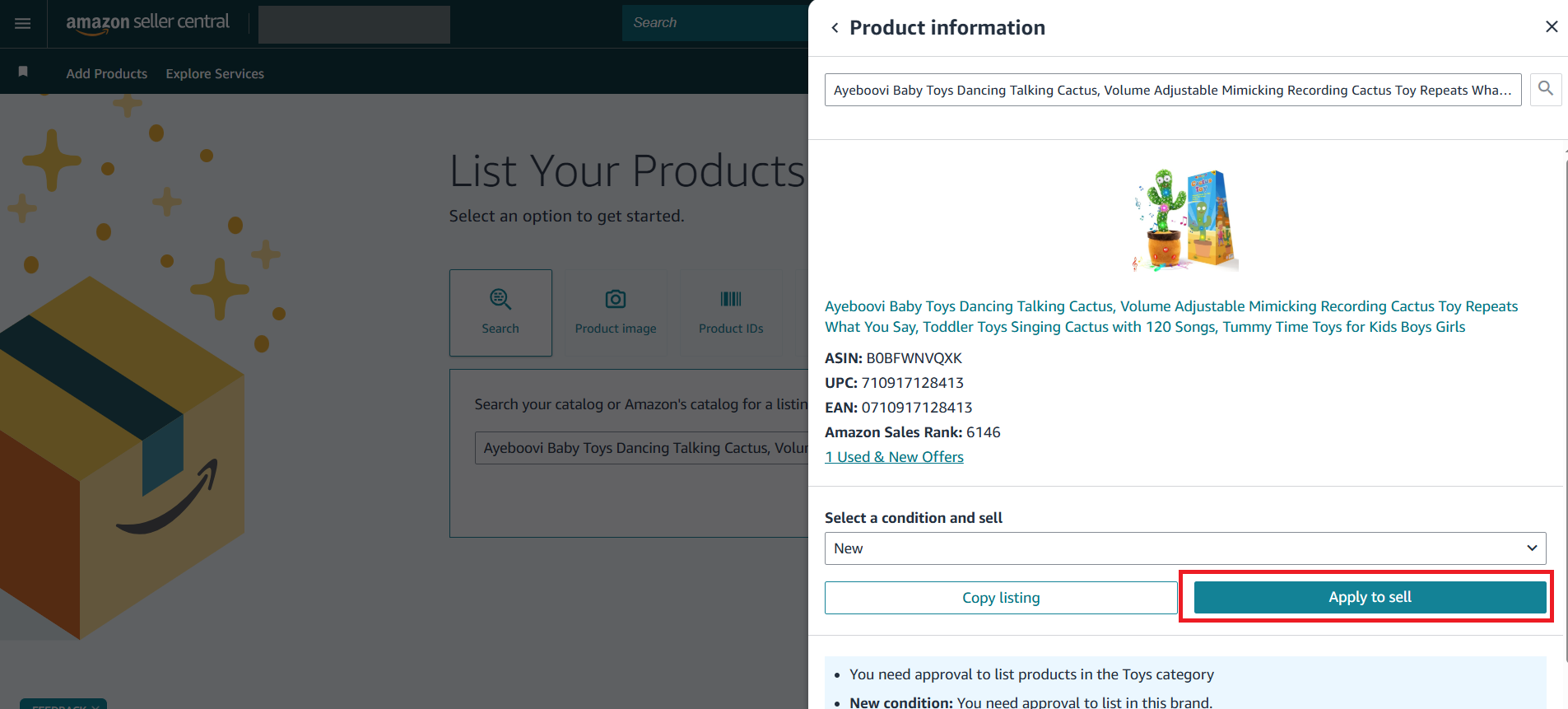
Step 4. Upload required documents
Clicking this button opens your application form. Amazon will ask for the documents needed to confirm compliance – typically your invoice for 10 units, product images, and any safety paperwork required for children’s products. Make sure your SKU, address, product details, and supplier information match exactly across your documents.

Step 5. Submit and monitor status
After attaching your documents, click Submit. To track your request, go to Catalog → View selling applications, where you can check whether your application is under review, approved, or needs more information.
Step 6. Wait for review
Amazon usually reviews toy approval requests within 2–7 business days. If your documents are clear and accurate, approval often arrives quickly; if anything is missing or unclear, Amazon may ask for additional information – or deny the request until corrections are made.
Tips to Ungate Toys
Ungating toy brands is easier when you follow Amazon’s documentation rules and apply with clean, consistent information. These tips help you avoid avoidable rejections, improve approval speed, and source the right products for successful ungating.
Buy from trusted retailers
Purchase your 10 units from reliable stores like Target, LEGO, Walmart, or other reputable retailers with proper invoices. These suppliers provide clean documentation Amazon easily verifies.
Choose low-cost items
For toy brands like LEGO, keychains and accessories make perfect ungating products because they’re cheap and easy to buy in bulk. You only need the 10 units to apply – profit isn’t required.
Match your address exactly
Amazon rejects applications when the address on your invoice doesn’t match your Seller Central account. Ensure your billing, shipping, and account address are identical before applying.
Take clear product photos
Upload photos showing all sides of the product so Amazon can confirm the items match your invoice. Clean, well-lit images reduce the chance of Amazon requesting additional documentation.
Avoid products without Amazon listings
Only buy items that already exist on Amazon. If the toy doesn’t have an ASIN, Amazon won’t accept your invoice for ungating.
Use multiple orders when needed
If a product has a quantity limit – like LEGO often does – place several orders to reach the required 10 units. Amazon accepts multiple invoices as long as all details match your account.
Reapply when denied
Denials are common, especially for toy brands. Upload clearer images and a fresh invoice, and if rejections continue, open a case or contact support to have an Amazon agent review your documents manually.
Start with easy toy brands
Some toy brands are simpler to ungate, such as Barbie, Hot Wheels, Nerf, and Funko Pop. Beginning with easier brands helps build your approval history, making future approvals faster.
FAQ
Do I need approval to sell every toy brand on Amazon?
Most major toy brands require individual brand-level approval, even if the category itself doesn’t need full ungating. Each brand has its own verification process, so you must apply separately for each one.
Can I use retail receipts instead of invoices for toy approval?
No – Amazon rarely accepts retail receipts for gated categories like toys. You must submit a proper invoice showing at least 10 units purchased from a reputable retailer or distributor.
How long does Amazon take to approve toy applications?
Most toy approval requests are reviewed within 2–7 business days. If your documentation is clear, approval often comes faster, but missing or inconsistent details can delay the process.
What happens if my toy approval request gets denied?
You can reapply with clearer images, corrected invoices, or updated information. If repeated denials occur, contact Seller Support and request a manual review.
Can I get ungated using different products than the one I want to sell?
Yes – you only need to purchase any product from the same brand to apply for brand approval. Once approved, you can sell all ASINs under that brand, not just the one you bought.
Final Thoughts
Getting approved to sell toys on Amazon may look complex, but once you understand brand-level ungating and gather the right documents, the process becomes straightforward. Clean invoices, accurate product photos, and proper safety certifications are the key to fast approvals – and sourcing from trusted retailers helps avoid unnecessary rejections.
To make toy sourcing easier, use Seller Assistant to check bulk restrictions, filter out blocked ASINs instantly, and focus only on products your account can actually sell. With tools like Price List Analyzer, you can verify eligibility, analyze profitability, and uncover strong toy deals in minutes.
Seller Assistant automates and connects every stage of your Amazon wholesale and arbitrage workflow. It brings together in one platform: workflow management tools – Purchase Orders Module, Supplier Database, Warehouse Database, bulk research & sourcing tools – Price List Analyzer, Bulk Restriction Checker, Sourcing AI, Brand Analyzer, Seller Spy, Chrome extensions – Seller Assistant Browser Extension, IP-Alert Extension, and built-in VPN by Seller Assistant, and integrations & team access features – seamless API connectivity, integrations with Zapier, Airtable, and Make, and Virtual Assistant Accounts.
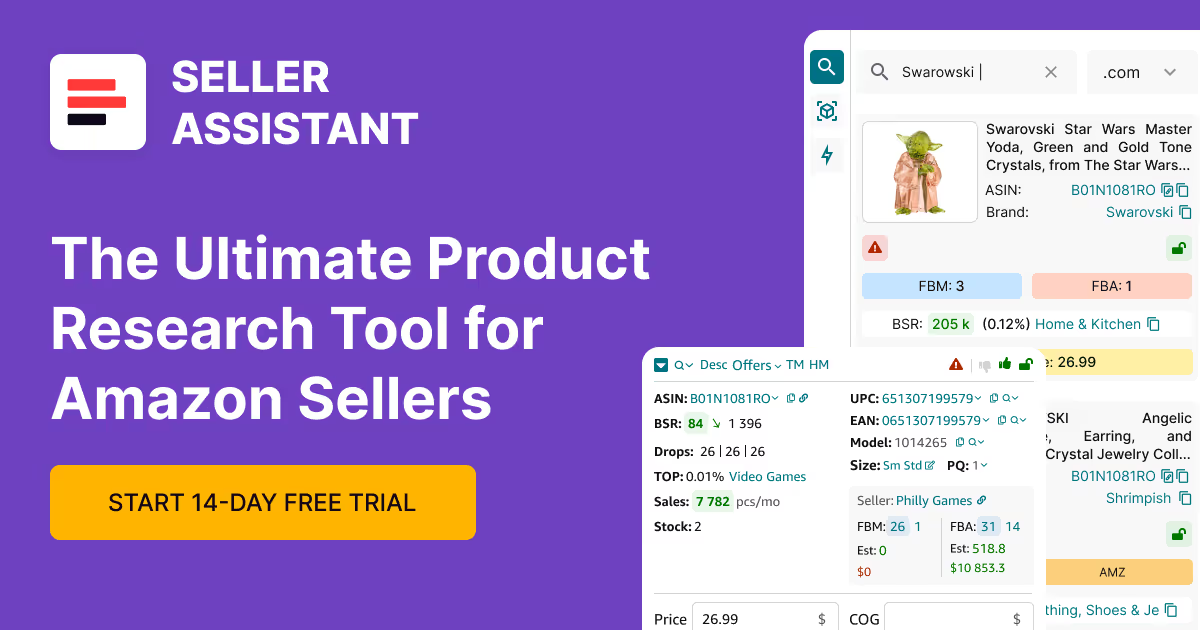
.svg)













